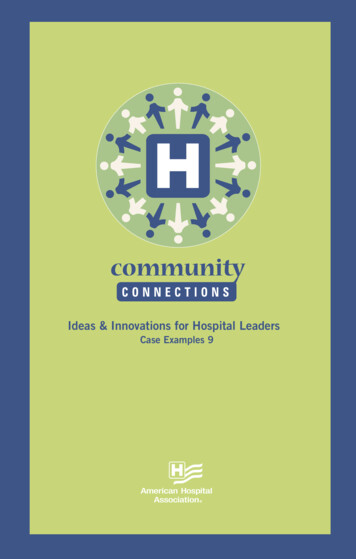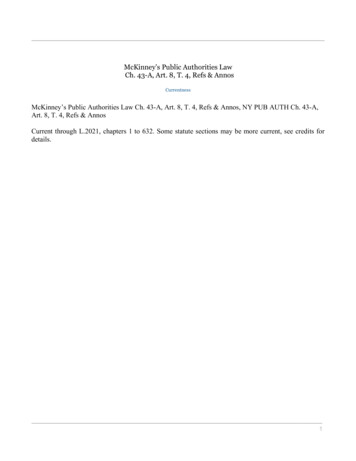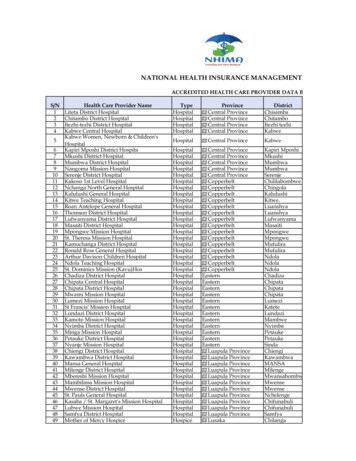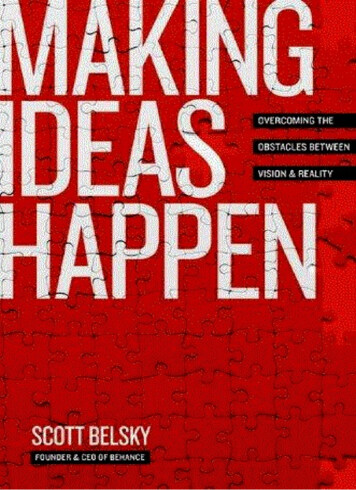
Transcription
Ideas & Innovations for Hospital LeadersCase Examples 9
In 2006, hospital leaders across the country received their first Community Connections resource—a collection of programsthat demonstrate the various ways hospitals provide for and benefit their communities. This case example book is theninth in a series and highlights many more innovative programs. For more examples or to share your own story, visitwww.ahacommunityconnections.org.Photos in this publication are courtesy of Doug Haight, photographer, and illustrate programs from recent Foster G. McGawPrize-winning organizations. Since 1986, the Foster G. McGaw Prize has honored health delivery organizations that havedemonstrated exceptional commitment to community service. The 2014 Prize is sponsored by The Baxter InternationalFoundation, the American Hospital Association and the Health Research & Educational Trust.
Today, more than 5,000This book highlights the unique andhospitals of all kinds —innovative ways hospitals are doingurban and rural, largethis work. Far from a comprehensiveand small — are making theirlist, Community Connections beginscommunities healthier in waysto illustrate where and how hospitalsthat are as diverse as the needsare meeting their communities’ manyof each community. The men andneeds. The stories cover four broadwomen who work in hospitals arecategories:not just mending bodies. Their work Social and Basic Needsextends far beyond the literal and Health Promotionfigurative four walls of the hospital Access and Coverageto where free clinics, job training Quality of Lifeefforts, smoking cessation classes,back-to-school immunizations,literacy programs and so manyothers are brought directly to thepeople of the community oftenwith very little fanfare.Every day in America’s hospitals, thereis tremendous good being done. Theinstantly recognizable blue and white“H” sign signifies more than a placethat patients and families can dependon for care. It signifies the heart of acommunity.
Table of Contents Social and Basic Needs.3 Health Promotion.11 Access and Coverage . 21 Quality of Life.29 Index. 37c o mmu n i t y c o n n e c t i o n s1
2American Hospital Association
Social and Basic NeedsNon-medical needs are often intricatelytied to personal health and well-being.Hospitals are working to address social,basic and personal needs as a way toimprove their communities’ health. Theprograms described on the following pagesillustrate approaches hospitals are takingto meet the basic needs of everyday life,from food and shelter to education andself-reliance, ultimately improving thelong-term health of communities.c o mmu n i t y c o n n e c t i o n s73
Social and Basic Needs Avera McKennan – Sioux Falls, South DakotaProgram: Ground Works PartnershipWhat is it? To address obesity, poor diet and lackof exercise, Avera McKennan has formed a newpartnership with Ground Works. Through thispartnership they financially support the developmentof teaching gardens at schools in Sioux Fallsneighborhoods identified as high-need areas. It ishoped the plots will engage students and adults inhealthy activity and encourage improved eating habitsand inclusion of fruits and vegetables in families’daily diets.Who is it for? Children and families in participatingSioux Falls schools.Why do they do it? Avera McKennan’s communityhealth needs assessment identified obesity/poordiet/lack of exercise as a critical community healthissue, but one with the most potential for success.Engaging children at a young age to establish healthyeating patterns is a key strategy, as is partnering withcommunity organizations like Ground Works.Impact: Ground Works’ goal is to reach 5,000students, their families and neighborhoods by 2015.Currently, the program serves 2,410 via the schoolteaching garden model.Contact: Lindsey MeyersDirector, CommunicationsTelephone: 605-322-7955E-mail: lindsey.meyers@avera.org Blanchard Valley Health System – Findlay,OhioProgram: GrandfriendsWhat is it? This educational daycare program beganin 2003 when the Marilyn and Gordon MacklinIntergenerational Institute developed a partnershipwith Blanchard Valley Health System to facilitateinteraction between retirement home residentsand adult day center clients with children agessix weeks to five years. Children learn from their“Grandfriends,” while the adults get to re-experiencethe joy of caring for a child.Who is it for? The elderly and young children whoneed daycare.Why do they do it? Many of the activities allow bothchildren and adults to practice motor skills, suchas molding Play-Doh and cognitive skills, suchas playing memory games. The games playedthrough this interaction all serve a purpose and aretherapeutic by design, allowing the children andadults to learn from one another and build their skillsin an intergenerational setting.4Impact: Each year, more than 700 elderly clients andup to 70 children participate in the program.Contact: Megan A. JamesCommunications CoordinatorTelephone: 419-423-5385E-mail: mjames@bvhealthsystem.org Carilion Clinic – Roanoke, VirginiaProgram: Adolescent and Student Health ServicesWhat is it? The Roanoke Adolescent HealthPartnership was established in 1992 by Carilion Clinicand its community partners to improve access tohealth care for children, provide pregnancy-preventioneducation and confidential services for teens and toreduce the rate of teen pregnancy. In January 2011,Carilion assumed ongoing responsibility for the threeteen health centers. The program is now known as theAdolescent and Student Health Services, operated bythe Carilion Clinic Children’s Hospital.Who is it for? Teens and pre-teens in Roanoke.Why do they do it? In 1991, Roanoke City had thehighest pregnancy rate in the state among teens ages15 to 19.Impact: The program now has two high school-basedclinics and a community clinic, where they had morethan 2,300 patient visits in 2011. Teen pregnancyrates have dropped from a high in 1995 of 72.8 per1,000 females to 42.8 per 1,000 females in 2010.Contact: Nancy Howell AgeePresident and Chief Executive OfficerTelephone: 540-981-8844E-mail: nhagee@carilionclinic.org Central Valley Medical Center – Nephi, UtahProgram: Poison PreventionWhat is it? During National Poison Prevention Week,the hospital’s pharmacy staff visits schools andeducates children about the dangers of poisoningsand how to prevent them. Students are challenged todo a home survey with their parents to help eliminateunnecessary poison from the home. The class withthe highest number of surveys returned wins a pizzaparty, courtesy of the hospital.Who is it for? Third-graders in the Juab SchoolDistrict and surrounding communities.Why do they do it? Poisoning – particularly fromoverdoses of over-the-counter, prescription and illicitdrugs – has surpassed falls to become the nation’ssecond-leading cause of unintentional death, aftermotor vehicle collisions. The majority of non-fatalpoisonings occur in children younger than six yearsold and more than 90 percent of these poisoningsoccur in the home.American Hospital Association
Impact: Every year, approximately 220 students gothrough the Poison Prevention event, which has beenheld for the past 10 years.Contact: Steve Breckenridge, RPhPharmacy DirectorTelephone: 435-623-3108E-mail: sbreckenridge@cvmed.net Citizens Memorial Hospital – Bolivar, MissouriProgram: Senior Health CenterWhat is it? The Citizens Memorial Hospital (CMH)Senior Health Center offers health and fitness-relatedservices designed for individuals 55 and older.Membership is free; services include open pooltime and hot tub use, exercise equipment, exerciseclasses, strength-building classes, blood pressuremonitoring, walking trail, lending library, computersand Internet access and health education.Who is it for? Individuals 55 and older in the CMHservice area.Why do they do it? The initiative was developedin response to community partnerships betweenCMH, the City of Bolivar, Polk County Health Centerand various local businesses and individuals whorecognized the need for affordable and accessiblehealth and fitness opportunities for seniors.Impact: Since the Senior Health Center’s opening in2004, 2,546 people have enrolled with an averageof 13 new enrollees per month. Member surveysindicate health benefits such as increased strength,more energy and decreased blood pressure.Contact: Jody PoolSenior Health Center CoordinatorTelephone: 417-777-7171E-mail: jpool1@citizensmemorial.com Community Medical Center – Missoula,MontanaProgram: Random Act of CommunityWhat is it? The Random Act of Community campaignsupports local small businesses and strengthens thesense of community in Missoula. Community MedicalCenter (CMC) pays for 100 to 150 small items such asan ice cream or coffee for area residents on any givenday unannounced. Local businesses are able to telltheir customers that the items about to be purchasedare free, courtesy of CMC. The initiative’s pay-it-forwardstrategy creates a positive sense of community amongresidents and helps support the local economy.Who is it for? Local, independent businesses andresidents of Missoula.Why do they do it? CMC wanted to give back to thelocal businesses in Missoula and spark a sense ofsocial responsibility by paying it forward.c o mmu n i t y c o n n e c t i o n sImpact: Missoula shoppers have indicated that thesurprise treat has inspired them to do other RandomActs of Community for other community members.Contact: Geoff PeddicordDirector, Marketing and Public RelationsTelephone: 406-327-4024E-mail: gpeddicord@communitymed.org Crestwood Medical Center – Huntsville,AlabamaProgram: BabypaloozaWhat is it? Crestwood Medical Center’s MaternityCenter was the presenting local sponsor of Huntsville’sfirst Babypalooza on Sept. 28, 2013. From healthservices to childcare centers to boutique shopping,moms were able to find everything they neededunder one roof, in one day. In addition to baby andmaternity exhibitors, there were prizes, giveaways,baby activities, unique baby items for purchase, achildren’s fashion show, a nursery design center,a child ID fingerprinting station, product sampling/demonstrations and a “Momarazzi” photo booth.Who is it for? Expecting moms and moms with youngchildren.Why do they do it? The purpose of Babypalooza is toconnect area moms with local resources, servicesand boutiques.Impact: The event had 2,500 to 3,000 attendees.Women with questions about the birthing process,prenatal classes, breastfeeding, etc., had theopportunity to seek advice from clinicians andeducators from Crestwood Maternity Center. Crestwoodalso provided educational seminars for dads to learnbasic baby-care skills from Crestwood nurses.Contact: Lori LightDirector, Marketing & Public RelationsTelephone: 256-429-4561E-mail: lori.light@crestwoodmedcenter.com Fairfield Medical Center – Lancaster, OhioProgram: Fairfield County Opiate Task ForceWhat is it? Composed of judges, hospital staff, lawenforcement, social service agencies, businessowners, recovery centers and community members,including recovering addicts and their familymembers, the task force offers providers professionaltrainings about the state database that helps identifypossible drug-seeking behavior and has implementedproper drug disposal days. The hospital instituteda policy in its emergency department to limit opiateprescriptions. For families struggling with drug abuse,the task force offers support groups and socialnetworking. The hospital also provides an educationalprogram for those caring for opiate-exposed infants.5
Social and Basic NeedsWho is it for? The entire community.Why do they do it? Drug abuse is the leading causeof death in Ohio. The community has seen drugabuse start with prescriptions, but when individualsrun out of money or access they advance to heroin,methamphetamine and, more recently, bath salts.Impact: Since 2000, demand for opioid addictiontreatment in Fairfield County has increased 500percent. According to community surveys, misuse ofprescription drugs has decreased.Contact: Cynthia PearsallChief Nursing OfficerTelephone: 740-687-8006E-mail: cynthiap@fmchealth.org Garden Park Medical Center – Gulfport,MississippiProgram: Excel By 5What is it? Initially funded by Chevron, GardenPark Medical Center’s Excel by 5 is an innovativecommunity awareness program that asks communitiesacross Mississippi to study how well they supportchildren under five and their families. The programidentifies gaps in community resources, encouragescommunity collaboration and volunteerism, promoteseconomic development and addresses children’sneeds with regard to education, health care, safety andchildcare. The program does not offer direct servicesbut builds the understanding of parents, grandparentsand caregivers of young children about the needs ofchildren from birth to age five.Who is it for? Children and families acrossMississippi.Why do they do it? By having early developmentalneeds addressed, children in Mississippi’scommunities are healthier and better prepared tobegin their formal education at age five.Impact: The program has helped hundreds of familieswith young children through resources providedin its community certification process, health fairs,education and awareness initiatives.Contact: Angela JuzangDirector, Marketing & Business DevelopmentTelephone: 228-575-7110E-mail: angela.juzang@hcahealthcare.com Indiana University Health – Indianapolis,IndianaProgram: Garden on the Go What is it? Garden on the Go is Indiana University (IU)Health’s year-round mobile produce delivery program.It is designed to improve access to affordable, freshproduce in under-resourced communities that wouldnot have easy access otherwise. IU Health works with620 community partners to host weekly stops, settingup the produce inside in a “mini farmers’ marketstyle” format. Cash, credit, debit and food stamps areaccepted for payment.Who is it for? Residents in Marion County.Why do they do it? Indiana ranks eighth in obesityamong states. Research shows that increasedproduce consumption can reduce the risk of obesity,lowering risk for chronic diseases such as diabetesand heart disease. Only two percent of MarionCounty residents consume the recommended dailyservings of produce.Impact: Since launching in May 2011, Garden on theGo has exceeded 42,000 sales transactions and soldmore than 180 tons of fresh, affordable produce.IU Health is exploring expansion of the programelsewhere in Indiana.Contact: Lisa ColeManager, Indianapolis Community OutreachTelephone: 317-962-1018E-mail: lcole3@iuhealth.org MaineGeneral Health – Augusta, MaineProgram: Waterville Downtown Farmers’ Market andthe Farmers’ Market at Mill Park in AugustaWhat is it? MaineGeneral sponsors farmers’ marketsto give their community a chance to meet theirneighbors while shopping for fresh, local foods.The Medical Center purchases much of the food itserves from local sources and market chefs havewon awards at high-profile events cooking with localfoods. A new MaineGeneral hospital, opened in2013, has a teaching kitchen to give free classes oncooking with local, healthy ingredients.Who is it for? Residents of the Kennebec Valley.Why do they do it? Buying local helps the localeconomy, and serving whole, nutrient-dense food isgreat for your health.Impact: Area residents meet their neighbors, learnmore about how to eat a healthy diet and gain accessto fresh local foods.Contact: Joy LeachCommunity Health Promotion SupervisorTelephone: 207-621-7266E-mail: joy.leach@mainegeneral.org Methodist Health System – Omaha, NebraskaProgram: Back-to-SchoolWhat is it? For the first time in the history of theprogram, Methodist Health System was a presentingsponsor of the KETV 7 Can Help Kids/SalvationArmy Back-to-School Backpack Program. Collectionbarrels were located at all three Methodist HealthSystem hospitals; Methodist Physicians Clinics inthe Omaha area and Council Bluffs, IA; MethodistAmerican Hospital Association
Health System Corporate offices; and NebraskaMethodist College. A one-day drop-off event was alsoheld at Methodist Women’s Hospital. In addition, freeback-to-school physicals were offered by MethodistPhysicians Clinic, other Methodist Health Systemproviders and med students.Who is it for? The program provides much-neededschool supplies for disadvantaged children in theOmaha and Council Bluffs community.Why do they do it? Every child deserves to begin theschool year the right way and that begins with thenecessary school supplies.Impact: In 2013, a record 13,400 children receivedsupplies, exceeding the previous year’s mark of11,000.Contact: Claudia BohnCommunications/Public Relations ManagerTelephone: 402-354-6818E-mail: Claudia.Bohn@nmhs.org Monadnock Community Hospital –Peterborough, New HampshireProgram: Fresh Chicks MarketplaceWhat is it? Each May through October, MonadnockCommunity Hospital (MCH) hosts the Fresh ChicksMarketplace (FCM). The FCM at MCH is a placewhere people experience a wide variety of localvendors who offer high-quality produce, products,skills and music. The marketplace educates andinforms people of the positive economic andsustainable impact that buying locally has on the localcommunity. FCM enjoys highlighting small businessesand non-profits, as well as donating weekly produceand products to area homeless shelters.Who is it for? The FCM offers one-stop shoppingfor all ages: fresh-picked local produce, homemadeproducts and baked goods, dairy, eggs, meats andlobster, many beautiful artisan crafts and more.Why do they do it? A venue for small farms, thisprogram gives back to the community, promotes selfsustainability and provides important local connections.Impact: The program helps revitalize local food cultureand increases the demands of healthy people, ahealthy environment and a healthy economy.Contact: Lee Ann ClarkCommunity RelationsTelephone: 603-924-1700E-mail: LeeAnn.Clark@mchmail.org North Country Hospital and Health Center –Newport, VermontProgram: Crisis Response & Bereavement Team (CRBT)What is it? North Country Hospital’s CRBT includesvolunteers from different departments who providec o mmu n i t y c o n n e c t i o n ssupport to patients’ families and friends during timesof unexpected loss of a loved one or when a crisishas occurred. Services range from helping withphone calls or getting food to just sitting with familyand friends while they wait. The volunteer also followsup by calling the family two weeks after the incidentand again three months later.Who is it for? Family members or friends of victims ofaccidents or sudden death.Why do they do it? It is very hard to experience theloss of a loved one, perhaps especially when death issudden or the victim is very young. It is comforting toknow that there are volunteers available when crisisor sudden death occurs.Impact: More than 200 families have been assistedby this team since its beginning in fall 2003.Contact: Rhonda Howard, RNEducation DepartmentTelephone: 802-334-7331, ext. 359E-mail: rhoward@nchsi.org Northern Arizona Healthcare – Flagstaff,ArizonaProgram: Safe Child CenterWhat is it? Founded in 1994, the Safe Child Centerat Flagstaff Medical Center assists child victims ofabuse or neglect through the provision of post-eventphysical examinations, forensic interviews, behavioralhealth counseling, sexually transmitted infectiondiagnostic tests, pharmaceutical treatment and othercritically needed services.Who is it for? Children, birth to 18 years, who arevictims of abuse or neglect.Why do they do it? This program meets a communityneed as the only child advocacy center in NorthernArizona.Impact: In 2012, 688 victims and their familieswere served, with 485 receiving crisis counseling.Behavioral health therapy services were provided to119 victims/families. Health status improvementsincluded 97 percent reporting increased knowledgeand understanding of violence, abuse and neglect,and its affect on their lives; 100 percent reportingincreased well-being and reduced anxiety level;100 percent reporting an increase in coping skills;and 93 percent of children demonstrating improvedemotional and behavioral status from intake todischarge.Contact: Richard SmithVice President, Development & MarketingTelephone: 928-773-2017E-mail: ra.smith@nahealth.com7
Social and Basic Needs Ochsner Health System – New Orleans,LouisianaProgram: Science Education Outreach InitiativeWhat is it? Since 2005, the Science EducationOutreach Initiative has increased health andscience career awareness and provided studentswith exciting science education experiences.Students are engaged through programs such asScience-Technology-Academic-Research (STAR),a five-week summer program where studentsparticipate in clinical rotations and conduct researchwith PhD scientists in the iLab, a free-of-chargeand professionally equipped research and learninglaboratory for students.Who is it for? Elementary, middle and high schoolstudents and teachers in Southeast Louisiana.Why do they do it? Although Louisiana is a 95 percentmedically underserved state, many academicallyadvanced, health care career-focused students leavethe state to pursue education and careers.Impact: More than 6,000 students, primarily fromlow-income communities, have been affected by theinitiative. STAR has accepted 82 students who haveexhibited a 100 percent college attendance rate. TheiLab has provided more than 1,100 students withopportunities to use real laboratory equipment andperform cutting-edge experiments.Contact: Avery CorenswetVice President, Community OutreachTelephone: 504-842-7133E-mail: acorenswet@ochsner.org Prairie Lakes Healthcare System – Watertown,South DakotaProgram: Window of Hope – A Grief Healing RetreatWhat is it? Facilitated by a Prairie Lakes pastoralcare representative and social worker, the one-dayGrief Healing Retreat encourages participants toshare feelings, questions and concerns as theywork through the normal grief process. This nondenominational retreat is offered at no cost andlunch is provided.Who is it for? People who are grieving a lovedone’s death.Why do they do it? The retreat is designed to bringpersons who have lost a loved one hope, healing andcomfort. It also gives participants an opportunity tomeet other people who are coping with the death ofa loved one.Impact: Twenty-one people attended the GriefHealing Retreat. Previously, this event was heldas a Bereavement Support Group that met for fiveconsecutive weeks. This new, one-day format provedto be more successful. The pastoral care team is8offering a follow-up event called “Beyond Death’sDoor” for people who attended the retreat.Contact: Elizabeth RuenPublic Relations SpecialistTelephone: 605-882-7000 or 605-882-7714E-mail: elizabeth.ruen@prairielakes.com Randall Children’s Hospital at LegacyEmanuel – Portland, OregonProgram: Child Safety ProgramWhat is it? Randall Children’s Child Safety Program isa three-pronged effort that is integrated into obstetricaland pediatric services in all five Legacy Health sitesin Oregon and Washington. The three separate andcollaborative, hospital-based child injury preventionprograms are the Child Passenger Safety (CPS)Program, Shaken Baby Prevention Program and theSafety Store and Resource Center, which includes anewer initiative targeting child window falls.Who is it for? Children in the communities served byLegacy Health.Why do they do it? The program’s goal is to protectchildren from the number one cause of death,disability and injury – predictable and preventable(both unintended and inflicted) injury.Impact: The Child Safety Program has been workingwith hospital staff to check the car seat for eachdischarge (338 in 2012). Also that year, CPS conductedapproximately 590 seat checks and provided 118 lowcost car safety seats to families in need. To date, CPShas recycled 7,000 car safety seats.Contact: Jaime HurstAdministrative Assistant, Nursing AdministrationTelephone: 503-276-6539E-mail: jhurst@lhs.org Renown Health – Reno, NevadaProgram: Healing ArtsWhat is it? Through the Healing Arts program,Renown Health partners with local art agencies, theUniversity School of Medicine and area school districtsto showcase original artwork from local and regionalartists, offer two healing garden spaces (one dedicatedspecifically to children’s needs), hold monthly concertsand performances open to the public and offer otherprograms that integrate art in a healing environment.More than 200 artists locally, regionally and globallyhave their art showcased at Renown.Who is it for? Patients, visitors, staff, artists and theReno community.Why do they do it? The program builds communityand supports the arts by connecting local artists andperformance groups with an untraditional venue anda grateful audience.American Hospital Association
Impact: Annually, Renown Regional Medical Centersees more than 750,000 visitors and holds 18community performances.Contact: Anna ZuckerDevelopment SpecialistTelephone: 775-982-5545E-mail: azucker@renown.org St. Anthony North Hospital – Westminster,ColoradoProgram: Growing HomeWhat is it? Growing Home is a volunteer-drivencommunity organization addressing homelessness,hunger and opportunities for at-risk children.Programs include an Interfaith Family Shelter,Homeless Prevention, an after-school program, afood pantry with hygiene items, health care services,educational classes and a community garden. St.Anthony North serves as the host site for the shelterprogram and helps the food pantry with food drives.Growing Home brings together diverse communitycongregations, a hospital, businesses, schools andmore than 1,500 volunteers to help children andtheir families.Who is it for? Families in need throughout the Denvermetro area.Why do they do it? More than half of the homeless inthe Denver metro area are families with children.Impact: Seventy-five percent of homeless families thatcomplete the shelter program move into stable housingand 90 percent of participants learn new parentingtechniques. In-home parent education has beenprovided to 100 families with kids ages zero to three,and 1,500 three-day food boxes have been distributed.Contact: Kathleen DrozdaPastoral Nurse CoordinatorTelephone: 303-426-2266E-mail: kathleendrozda@centura.org St. Mary’s Regional Medical Center –Lewiston, MaineProgram: Nutrition Center of MaineWhat is it? The Nutrition Center promotescommunity health through organizing, advocacyand education. Programs include emergency fooddistribution (St. Mary’s Food Pantry); hands-oncooking and nutrition education for all ages;community gardens for low-income families (Lots toGardens); garden education programs for children;FoodCorps programs in public schools; intensivejob training programs for teens; three summerand winter farmers’ markets; and collaborativecommunity assessment and planning activities.c o mmu n i t y c o n n e c t i o n sWho is it for? Families and individuals of all ages andbackgrounds at an increased risk for food insecurityand poor health.Why do they do it? Increasing access to healthy foodis a strategy for improving community health.Impact: More than 600 children, teens and adultsparticipate in hands-on cooking education classesannually and 115 families grow food in communitygardens. The food pantry serves approximately 1,500households a month. Surveys show that participantsincrease healthy food use after engaging in NutritionCenter programming.Contact: Kirsten WalterDirectorTelephone: 207-513-3848E-mail: kwalter@stmarysmaine.com St. Vincent Health – Indianapolis, IndianaProgram: Crooked Creek Neighborhood PartnershipsWhat is it? St. Vincent Indianapolis Hospital wasinstrumental in founding the Crooked CreekCommunity Development Corporation (CDC), whosemission is to improve housing, public infrastructureand commercial areas in this NorthwestIndianapolis community. St. Vincent continues toplay a key role in supporting CDC initiatives suchas the Hub, a place where neighbors gather, learnand work. St. Vincent also supports the Fay BiccardGlick Neighborhood Center at Crooked Creek, whichprovides numerous health outreach programs.Who is it for? People who live in, work in and visit theCrooked Creek community.Why do they do it? Over the past decade, theculturally and economically diverse Crooked Creekneighborhood has experienced significant declinedue to home foreclosures and business closures.Impact: Through the CDC’s efforts, 10 homes havebeen purchased, rehabbed and made availableto low-income, first-time buyers; 25 families haveavoided eviction through emergency rental loans;80 low-income seniors and disabled residents havereceived home repairs that allowed them to stayin their homes; a new congregate-living home forseniors has opened; and three homes have beenrehabbed for developmentally disabled residents.Contact: Jon WhiteSystem Communications ConsultantTelephone: 317-962-3965E-mail: jjwhite@stvincent.org9
Social and Basic Needs St. Vincent’s Medical Center – Bridgeport,ConnecticutProgram: St. Vincent’s SWIM Across the SoundWhat is it? St. Vincent’s SWIM Across the Sound,now in its 26th year, provides cancer education,screening and support services ranging fromprevention to survivorship programs. The SWIM alsooffers a significant safety net by providing financialassistance to cancer patients and their families. Itis of
Contact: Jody Pool educators from Crestwood Maternity Center. Crestwood Senior Health Center Coordinator also provided educational seminars for dads to learn Telephone: 417-777-7171 E-mail: jpool1@citizensmemorial.com Community Medical Center - Missoula, Montana Program: Random Act of Community What is it? The Random Act of Community campaign











